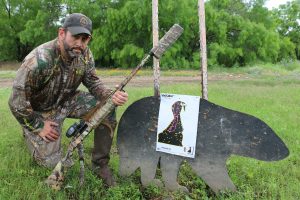In a perfect scenario, a gobbler will stride into the open, pause and lift his head high, giving you a softball shot at a still target. But spring turkey hunting rarely offers perfect situations. Birds could come in from your left, right or behind you. Some will bob and weave through the timber, pausing only long enough for a fleeting opportunity. Others will hang on the edge of range, leaving you wondering if you should shoot.
Hunters face those quandaries every spring, yet few prepare for them. We often focus on honing our calling skills and finding new places to hunt while ignoring shooting considerations. Don’t make that mistake this year. Prepare for the moment of truth so you can pull the trigger with confidence.
Find Your Perfect Setup
It’s amazing how many hunters know nothing about their choke constriction or how their gun patterns at 20, 30 and 40 yards with specific loads. Don’t be that guy.
Fine-tune your shotgun’s performance by shooting various loads through several chokes during the off-season. This doesn’t have to get too technical. Look for combinations that provide dense, even patterns with no holes. Don’t just buy a choke labeled “Turkey Super-Full.” Know the constriction. For 12-gauge shotguns, you’ll want a choke somewhere in the .650 to .680 range. Remember: tighter chokes generally perform better with smaller shot; looser constrictions with larger pellets. You’ll also want to use somewhat looser chokes — say about .675 in a 12-gauge with a standard .729-inch bore — with heavier-than-lead shot.
Find your effective range by shooting patterns at 5- to 10-yard increments, striving to place at least 100 pellets in a 30-inch circle. The farthest distance at which your gun, load and choke do so is your effective range. Learn that, and stick to it. Likewise, become familiar with your bead, sight or optic. Know how it performs, and keep it in top working order. Aiming at a turkey opening day should be instinctive, not stressful.
Practice Does Make Perfect
 Too often, we shoot turkey targets off a comfortable bench. That’s fine for patterning, but you should practice shooting from the position in which you’ll usually hunt, whether that’s sitting by a tree or in a blind using a shooting stick.
Too often, we shoot turkey targets off a comfortable bench. That’s fine for patterning, but you should practice shooting from the position in which you’ll usually hunt, whether that’s sitting by a tree or in a blind using a shooting stick.
Learn how far you can angle your gun left or right. Make sure you can easily adjust or move your gun when a gobbler pops into view. And if you’re using an optic, be sure you have enough eye relief to avoid “scope eye” opening morning.
Also, it never hurts to practice shooting with your off hand — left-handed if you’re a righty, and vice versa. Turkeys sometimes appear at 90 degrees from your right or left, making it almost impossible to move your gun and shoot without being seen. However, righties can sometimes slowly switch to left-hand mode and shoot turkeys to their right. The same goes for lefties with birds that appear to their port side. It takes some practice, though, so get comfortable with it during the off-season.
Envision
Only experience can prepare you for the infinite types of shot opportunities you might face this spring. Still, it helps to envision scenarios and practice squeezing the trigger, holding fire or adjusting your gun.
Learn to pick out open spots in the timber, and practice flowing your gun with a turkey to that shooting lane. Ready yourself to shoot almost instantly when a gobbler raises his head and prepares to leave. And practice mouth-calling while keeping your gun mounted and ready. That helps immensely if you must “cut” or “kee-kee” to make a gobbler break strut and lift his head.
Shoot First
However you prepare, don’t ignore shooting skills this off-season. It pays to become familiar and comfortable with your gun. That way, as soon as a gobbler offers a shot this spring — perfect or otherwise — making good on the opportunity will be second nature.
This article originally appeared in the 2017 Whitetail Journal Digital Turkey issue. You can view the entire magazine online here.






